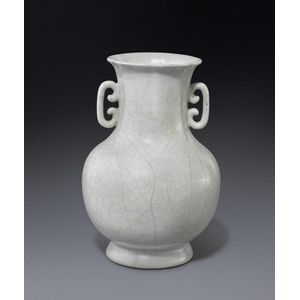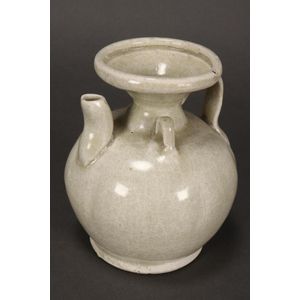Green Glazed Song Dynasty Ewer with Loop Handle
You must be a subscriber, and be logged in to view price and dealer details.
Subscribe Now to view actual auction price for this item
When you subscribe, you have the option of setting the currency in which to display prices to $Au, $US, $NZ or Stg.
- Song Dynasty - The Song Dynasty was a ruling dynasty in China from 960 to 1279 AD. It was divided into two periods, the Northern Song (960?1127) and the Southern Song (1127?1279). The emperor was the ultimate authority, but he relied on officials who were selected based on their merit and skills rather than their family background or social status. The Song Dynasty was a period of great artistic and cultural achievements, particularly in the areas of poetry, painting, and calligraphy. The Chinese invented the printing press during this period, which revolutionized the spread of knowledge and ideas. During the Song Dynasty, China had a prosperous economy and was a centre of international trade, particularly in luxury goods such as silk, tea, and porcelain. The use of paper money became more widespread during this period, facilitating commerce and trade.
- Ewer / Pitcher - A type of jug with a narrow neck bulbous body and wide spout, originally used for carrying and storing liquids such as water or wine. In medieval times they were the source of water to wash ones hands during and after a meal. later the shape was used for vessels in silver, gold, glass and ceramics.
In Victorian times they were made in ceramics and occasionally glass with a matching basin, and sometimes other accessories such as a soap holder or toothbrush holder. Their purpose was to provide facilities for personal washing In the early 19th century were often enclosed in purpose built stands, and later resided on a washstand..
Sometimes the words "ewer" and "pitcher" are used interchangably, but a pitcher is generally considered to be a jug, and would have a wide mouth, and a gently tapering body.
This item has been included into following indexes:
Visually similar items

Chinese celadon vase. Dual handled, with moulded leaf decoration. Possibly late Qing or Republic period H35 cm

Chinese celadon vase. Dual handled, with moulded leaf dec. Possibly late Qing or Republic period. Height 35 cm

A Guan-type vase, seal mark of Qianlong, the globular body rising from a spreading foot to an hexagonally lobed slightly waisted neck flaring to the scalloped rim, and flanked by a pair of C-scroll handles, covered overall with a pale greyish green glaze s

New Zealand Pottery, 2 ewers and a large unidentified vase
